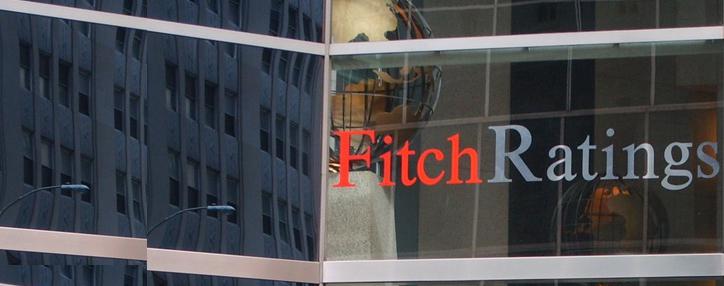Fitch Ratings revises its rating and sector outlooks to stable for 2017 from negative in 2016
12.12.2016,
17:53
Fitch Ratings said it has revised its rating and sector Outlooks to Stable for 2017 from Negative in 2016 as it expects that continued healthy economic growth – driven by external trade combined with a moderate recovery in domestic demand – and relative currency stability will support gradual improvements in banking sector profitability and asset quality.

YEREVAN, December 12. /ARKA/. Fitch Ratings said it has revised its rating and sector Outlooks to Stable for 2017 from Negative in 2016 as it expects that continued healthy economic growth – driven by external trade combined with a moderate recovery in domestic demand – and relative currency stability will support gradual improvements in banking sector profitability and asset quality.
The agency forecasts average GDP growth of 3.6% in 2017-2018 (2016: 3.5%), as the external environment including Russia and the wider CIS region becomes less challenging.
Fitch ratings estimates that the sector will need to raise AMD77bn of capital at end-11M16 (14% of the end-3Q16 stock) to meet the new AMD30bn minimum capital requirement (up from AMD5bn) effective from January 2017.
It says only 11 banks (69% of sector) met this limit at end-11M16. This has triggered some consolidation in the sector and has become an additional factor constraining growth among mid-sized/smaller banks.
‘We expect consolidation to continue in 2017 as competitive and regulatory pressures increase. Moderate Growth Prospects: Credit growth was moderate at 6% in 9M16, following contraction by 4% (FX adjusted) in 2015. We expect a moderate recovery in credit demand over 2017, supported by favorable macro trends, decreased pressure on the Armenian dram and a downward adjustment of market interest rates. However, loan growth is likely to stay at single-digit level, constrained by weak asset quality, subdued household consumption affected by still falling remittances and high central bank mandatory reserve requirements.’
‘We expect some stabilization of asset-quality trends in 2017, as spill-over effects from external shocks have faded. However, borrower performance will remain sensitive to recovery in domestic demand, which we expect to improve only moderately in the near term. Regulatory NPLs (loans up to 270 days overdue, loss loans over 270 days overdue are written off) hovered around 10% in 9M16 (end-2015: 9%); reserve coverage of NPLs was moderate at 41% at end-1Q16 (the last date when this was publicly reported). Stabilizing Profitability: Sector earnings turned positive on a monthly basis from March 2016 after moderate losses in 2015.’
Stabilization has been driven by some recovery in lending volumes, led by the corporate segment, and decreased but still sizeable impairment charges (equal to around 88% of pre-impairment profit in 9M16; 2015: 114%). The sector net interest margin hit a new low of 4.5%. We expect profitability to remain modest, with upside dependent on growth and improvements in asset quality. Stronger Capital Buffers: The increased minimum capital requirement (announced by the central bank at end-2014) has fuelled capital growth in 2015-2016. Coupled with slow growth and only moderate losses (2015), the sector’s regulatory capital ratio improved to 18.4% at end-3Q16 from 14.5% at end-2014.
We forecast capital adequacy levels to be largely maintained in 2017, given only moderate growth expectations and modest positive profitability. Manageable Refinancing Risks: External liquidity is sufficient to service maturing obligations, although the sector’s external debt (32% of liabilities at end-1H16) remains above regional peers. The long-term maturity profile of external borrowing, mainly raised from IFIs and nonresident related parties, limits refinancing risks. Outlook Sensitivities Operating Environment: The rating and sector outlooks are sensitive to the performance of the domestic economy and the stability of the dram.
A deterioration in operating conditions, resulting in a marked weakening of asset quality or capitalization, could result in rating downgrades. Improvements in the economy would reduce downward pressure on Ardshinbank (‘B+’/Negative) and would be supportive of Ameriabank’s (‘B+’/Stable) credit profile, although upgrades are unlikely in the near term, given that the banks are rated in line with the sovereign. -0-
The agency forecasts average GDP growth of 3.6% in 2017-2018 (2016: 3.5%), as the external environment including Russia and the wider CIS region becomes less challenging.
Fitch ratings estimates that the sector will need to raise AMD77bn of capital at end-11M16 (14% of the end-3Q16 stock) to meet the new AMD30bn minimum capital requirement (up from AMD5bn) effective from January 2017.
It says only 11 banks (69% of sector) met this limit at end-11M16. This has triggered some consolidation in the sector and has become an additional factor constraining growth among mid-sized/smaller banks.
‘We expect consolidation to continue in 2017 as competitive and regulatory pressures increase. Moderate Growth Prospects: Credit growth was moderate at 6% in 9M16, following contraction by 4% (FX adjusted) in 2015. We expect a moderate recovery in credit demand over 2017, supported by favorable macro trends, decreased pressure on the Armenian dram and a downward adjustment of market interest rates. However, loan growth is likely to stay at single-digit level, constrained by weak asset quality, subdued household consumption affected by still falling remittances and high central bank mandatory reserve requirements.’
‘We expect some stabilization of asset-quality trends in 2017, as spill-over effects from external shocks have faded. However, borrower performance will remain sensitive to recovery in domestic demand, which we expect to improve only moderately in the near term. Regulatory NPLs (loans up to 270 days overdue, loss loans over 270 days overdue are written off) hovered around 10% in 9M16 (end-2015: 9%); reserve coverage of NPLs was moderate at 41% at end-1Q16 (the last date when this was publicly reported). Stabilizing Profitability: Sector earnings turned positive on a monthly basis from March 2016 after moderate losses in 2015.’
Stabilization has been driven by some recovery in lending volumes, led by the corporate segment, and decreased but still sizeable impairment charges (equal to around 88% of pre-impairment profit in 9M16; 2015: 114%). The sector net interest margin hit a new low of 4.5%. We expect profitability to remain modest, with upside dependent on growth and improvements in asset quality. Stronger Capital Buffers: The increased minimum capital requirement (announced by the central bank at end-2014) has fuelled capital growth in 2015-2016. Coupled with slow growth and only moderate losses (2015), the sector’s regulatory capital ratio improved to 18.4% at end-3Q16 from 14.5% at end-2014.
We forecast capital adequacy levels to be largely maintained in 2017, given only moderate growth expectations and modest positive profitability. Manageable Refinancing Risks: External liquidity is sufficient to service maturing obligations, although the sector’s external debt (32% of liabilities at end-1H16) remains above regional peers. The long-term maturity profile of external borrowing, mainly raised from IFIs and nonresident related parties, limits refinancing risks. Outlook Sensitivities Operating Environment: The rating and sector outlooks are sensitive to the performance of the domestic economy and the stability of the dram.
A deterioration in operating conditions, resulting in a marked weakening of asset quality or capitalization, could result in rating downgrades. Improvements in the economy would reduce downward pressure on Ardshinbank (‘B+’/Negative) and would be supportive of Ameriabank’s (‘B+’/Stable) credit profile, although upgrades are unlikely in the near term, given that the banks are rated in line with the sovereign. -0-



